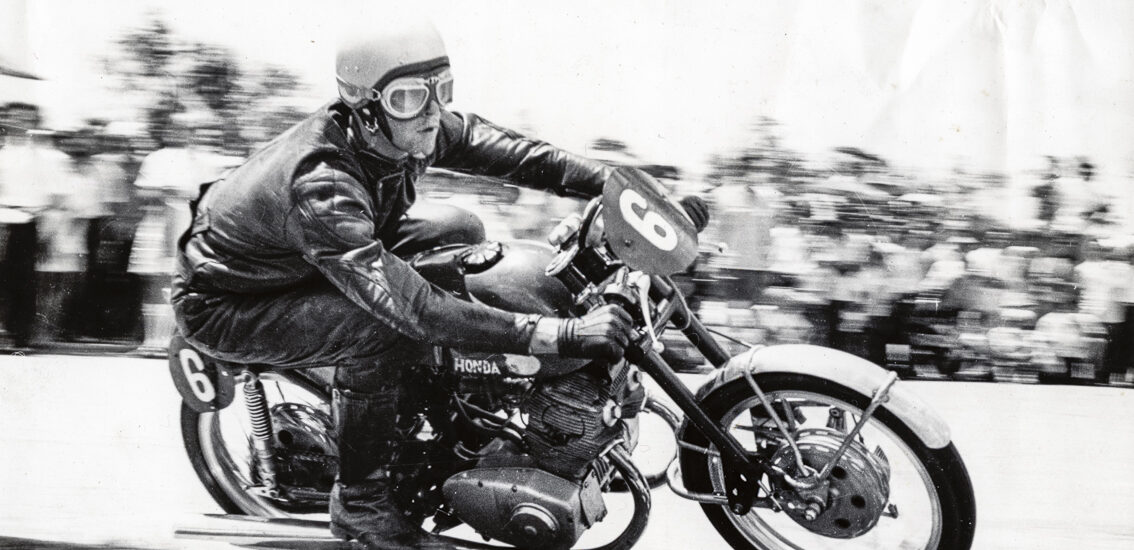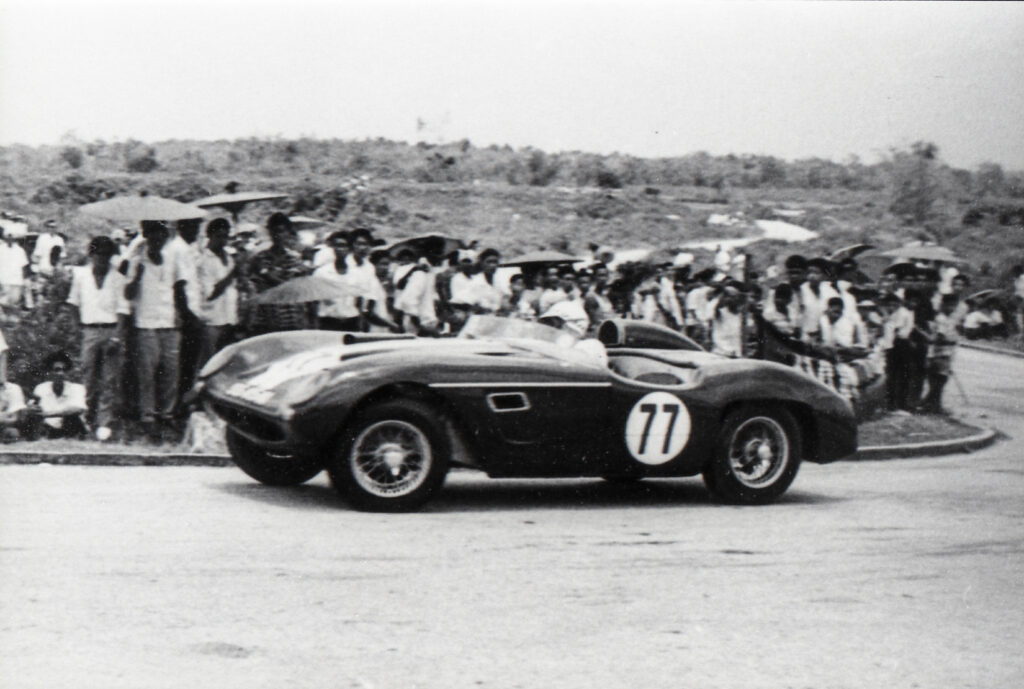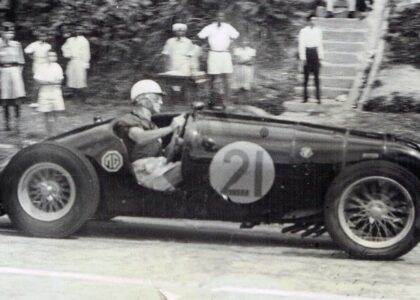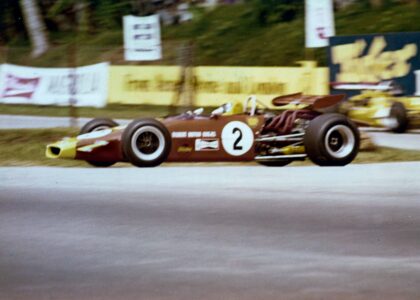Chris Proffitt-White and the golden age of the sprint
Words by Eli Solomon
This article first appeared in REWIND MAGAZINE 038, January 2018. Additional material and photos have been added to this article. My apologies to the local racing heritage gurus for once again trespassing into their airspace.
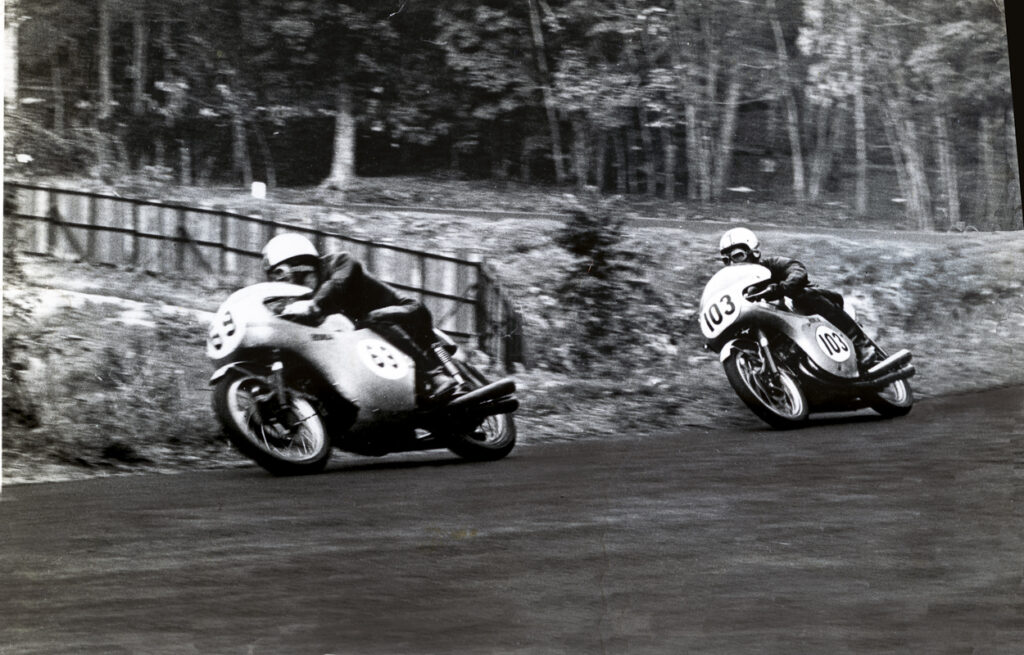
Caption: Two very rapid Honda Fours battle for the lead in the inaugural Singapore Grand Prix in 1961. Honda’s ace Giichi Suzuki (#69) was moments away from crashing his bike, handing the lead and victory to RAF Seletar technician Chris Proffitt-White (#103).
He arrived in Singapore in late 1959 as an aircraft technician at RAF Seletar, and when he headed back home to Warwickshire in February 1962, Christopher Proffitt-White, or Prof., as he was affectionately referred to, was a motor racing legend in South East Asia, the only man to have taken the game to the kamikaze Japanese riders in a Works Honda Four against their own machines.
AIRFIELD RACING
At RAF Seletar, Prof worked on the British aircraft fleet, including the twin-engine Armstrong Whitworth Meteors, Bristol Beaufighters, and Blackburn Beverleys that were allocated to HQ FEAF. In the late 1940s and 1950s, the base was heavily involved in the Malayan Emergency, with Beaufighters, Spitfires and Mosquitos based there while operating against Malayan Communist insurgents. During the 1960s, the RAF Seletar squadrons were engaged in operations in North Borneo during the Indonesia-Malaysia confrontation.
By the late 1950s, once the communist threat had been somewhat quelled, life at RAF Seletar and RAF Tengah became less hectic. Prof’s arrival in 1959 coincided with final flights over Singapore of the R.A.F.’s Short Sunderland flying boat patrol bomber (later replaced by the Avro Shackleton). This period coincided was what this author calls the golden age of the sprint – sprints run largely by colonial forces stationed throughout the Malay Peninsula, and held at various locations – usually forces-controlled air bases and camps.
While the defence of the island still lay with the British, life had by now returned to normal for the local population. By 1960, local motor sport enthusiasts had been starved of circuit racing for seven years (the last Johore Grand Prix was held in 1953). There was a reprieve – the RAF Changi circuit race organised jointly by the Forces Motoring Club and the Singapore Motor Club (SMC) was a one-off in 1957.
Expectations were at a new high when the local clubs were made aware of the upcoming Johore Coronation Grand Prix to be held in February 1960. The Grand Prix celebrated the crowning of Sultan Sir Ismail of Johore, the new Ruler of the State. The Emergency had ended and the majority of the remaining Communist guerrillas had been confined to the Thai border. The Macau Grand Prix was now part of the annual Asian racing calendar, and it was time for Singapore and Malaysia to plan for bigger events outside of the usual hill climbs and sprints. There was definite excitement in the air.
Following the 1960 Johore Grand Prix in February (won by Singapore Motor Club Captain Bill Wyllie in a DKW 1000RS – see https://rewind-media.com/2021/06/22/on-the-stroke-of-two/), RAF Seletar’s motoring enthusiasts sprung to action. On Sunday, 27 March 1960, a standing-start quarter-mile sprint was held at the Seletar Airfield, the first such event at the airbase. Organised by SMC, it had taken Bill Wyllie nearly two years to negotiate for the use of the airstrip for a motor sports event. It was timely because motor sports was no longer permitted at the SMC’s usual sprint stretch on Lim Chu Kang Road. The Seletar course consisted of a 150-yard-wide tarmac area with a large parking apron on one end that acted as a car park and scrutineering area. It had a flat straight over half a mile long that gently dipped towards the Johore Straits. A crash wagon, a fire tender, and a team of R.A.F. police, lent support in the event of an accident.
THE MAN WHO BEAT DUKE
So who was this young, 22-year-old, aircraft technician that took the game to the Works riders from Japan? Prof’s first appearance at a race meeting in Singapore was in October 1960, at a driving test organised by the Seletar Auto Club. The press got his name wrong – was it Profit with a double-F and a double-T? No matter. The records don’t reflect which car or bike he entered, but photos from his family albums suggest the car was either a Riley Pathfinder or his MGA. The bike might have been racing champion Chris Conn’s old Norton Featherbed with Triumph motor.
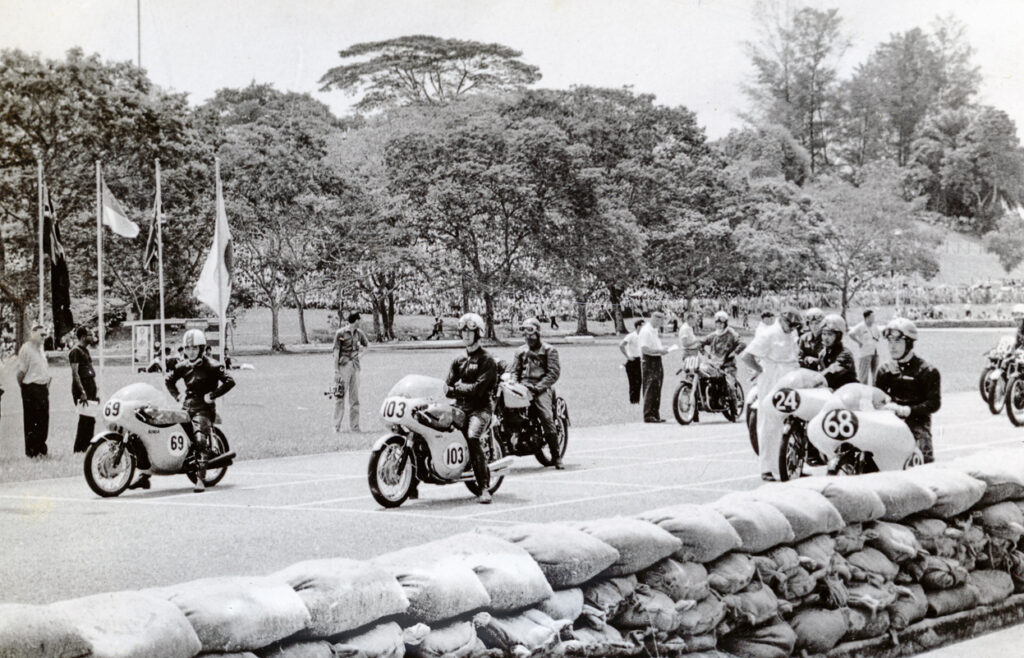
Caption: Calm before the storm as Asia’s top riders psych themselves out ahead of the start of the 1961 Johore Coronation Grand Prix. Hondas dominated the front row with Giichi Suzuki (#69) and Chris Proffitt-White (#103). Yamaha’s Hiroshi Hasegawa (#68) is alongside.
In November 1960, Castrol sponsored the year’s biggest motor cycle race at RASC Sembawang Nursery Circuit. As it was a major bike event, organised by the Singapore Motor Club and the Forces Motoring Club, special attention was given to the participants, and here, the public were introduced to Prof. One journalist wrote that the “fair haired Englishman” had acquired K.C. Wong’s four-speed 247cc Honda twin, probably the RC71. Another reported that Prof had bought Chris Conn’s Norton Featherbed frame and fitted a new 500cc Triumph motor (Conn’s Triumph motor had fallen apart during the 1960 Johore Grand Prix so Prof had a new one built). More sensational was journalist G. Subhas’ article titled, “The man who beat Duke: He will ride in Singapore.” Alongside this very press clipping Prof kept, he wrote, “This write up about myself is a little far-fetched. Who is this chap called Surtees?? Anyway…” Prof raced the Honda Twin around the Sembawang Nursery Circuit.
FACTORY CONTACT
Prof had been in touch with the Honda factory in 1959. On 17 December 1959, he had written to I. Neuchi, Chief of Service Section, Export Department of the Honda Motor Company, requesting a 250cc Super Sport for the 1960 Johore Grand Prix. The rejection from Honda was dated 19 January 1960 but Neuchi wished the lad all the best. The lines of communication had now been established with Honda and with local Honda agents Boon Siew Ltd. In the meantime, K.C. Wong’s old Honda Twin did perfectly well for Prof in place of the Norton-Triumph for the November 1960 Sembawang Races.
Prof had to acquaint himself not just with his newly acquired Honda Twin but with the Sembawang circuit as well. A test ride earlier suggested that the airman from Seletar was terribly uncomfortable with the track, calling it a “cross between a racetrack and a scramble course.” There was sand everywhere and he was assured that this would be swept off before every meet. And yes, there were dogs and cows to avoid as well around this 1.2-mile track that was really a driver-training track under the Royal Army Service Corps. In 1960, it was still the only track where massed-start racing was permitted in Singapore.
None of the locals really had a measure of how good Prof was, only that he had raced a BSA Gold Star in the 1959 British Motor-Cycle Racing Club Championships (Bemsee) against the likes of Geoff Duke, John Surtees and Mike Hailwood at circuits such as Aintree, Brands Hatch, Crystal Palace and Oulton Park. Granted, he wasn’t going to face such competition at Sembawang, there were still local favourites who knew the lay of the land: Soh Guan Bee, K.C. Wong, Cheng Teck Meng and Louis Chia. Soh, with a Norton Manx, was favourite, having had a successful trip in the Indonesian Grand Prix where he finished second in the 500cc race. K.C. Wong was expected to be in a new 250cc Yamaha, while Cheng had a 175cc Gilera.
No, Prof didn’t mop up all the trophies. He pulled out on lap 13 of the main massed-start 25-lap race with technical issues. But not before he had lopped off 1.8 seconds from the course record set a year earlier by Chris Conn. Yes, FTD in the bag. Soh won the race in his Norton. FTD aside, Prof took wins in the 350cc and under, and the 250cc and under 15-lap races in his No.6 Honda Twin, a bike that had been modified with brakes and gear lever swapped around to follow British motorcycle convention. The new circuit record for motorcycles – 1 minute 8.6 seconds.
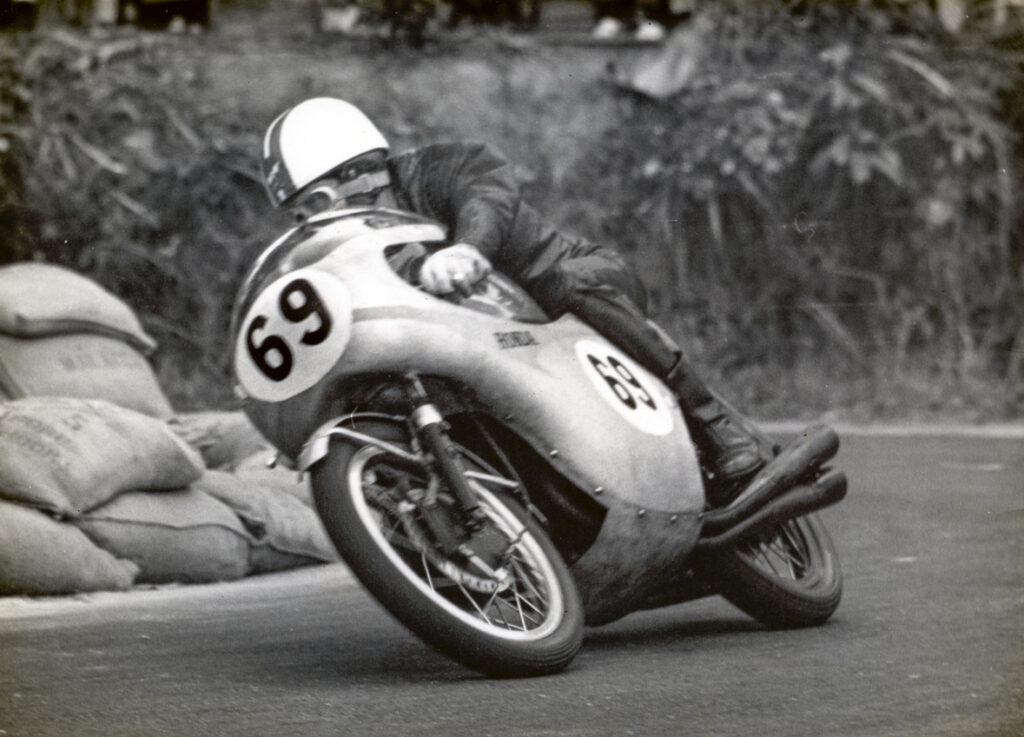
THE FASTEST
Feeling rather poorly the morning following the event, Prof was admitted to RAF Changi’s hospital to have his appendix extracted. That derailed his intention to enter his Honda Twin and his MGA in the November 1960 Old Upper Thomson Road Sprint. He also missed the February 1961 Old Upper Thomson Road Sprint.
If you took a look at the 1961/62 events calendars for the region (Singapore, Malaysia, Brunei), counting all forms of racing and club events, there were just under 120 events a year! Yes, that many! Once Prof was back on his feet, there was little time to spare before April’s Gap Hill Climb and Forces Motoring Club’s Spring Sprint at Sembawang, May’s Seletar Quarter Mile Sprint and June’s Johore Grand Prix in 1961.
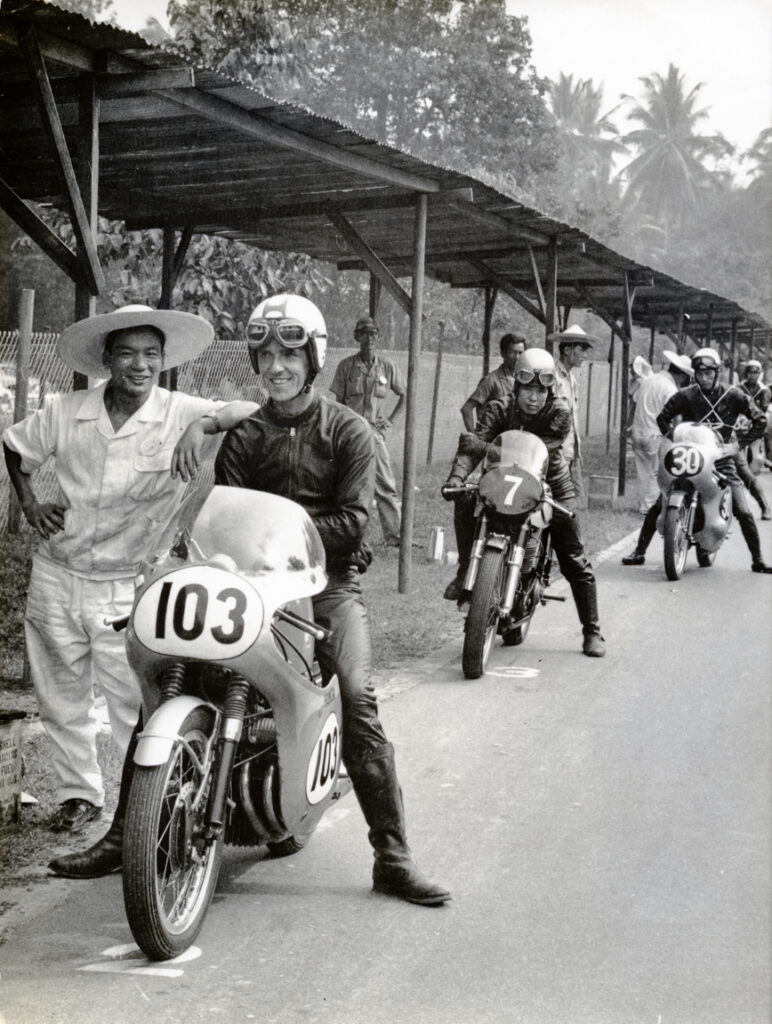
If racing wasn’t exciting enough, maintaining fighter aircraft at Seletar must have been equally challenging. On Friday, 13 April 1961, he was aboard a Meteor NF TT20 with army troops when it crash-landed after a military exercise. Damage was considered Cat III, requiring a specialist team to repair the damage instead of the squadron personnel. He survived intact. Exactly a week following the crash was the Forces Motoring Club’s Spring Sprint at Sembawang. Interestingly, Prof withdrew his entry for the event after inspecting the circuit. He was often critical of circuit conditions and suitability but had never scratched an entry previously. Was the withdrawal a consequence of the Meteor incident a week earlier?
ALL ABOUT WINNING
The real calling was the Grand Prix, around the streets of Johore, set for Sunday, 25 June 1961. Prof’s mount was a 1961 RC161 Honda Four from Honda. The entry list shows Prof with bike number 13, and you can wager that the Englishman put in a request to Honda to have this altered. To-ing and fro-ing took place before his proposed cunning plan to put “nothing” between the “1” and “3” was agreed upon. His entry finally read 103. Japanese factory rider Giichi Suzuki had the newer RC162 Four.
The Johore Grand Prix for motorcycles was the penultimate event that weekend and was eagerly anticipated. The race distance had been reduced at the request of the Japanese riders. For the first time in motor racing history in Malaya, the Yamaha factory in Japan sent two of their star riders, Osamuri Mochizuki and the well-liked Hiroshi Hasegawa, to compete in the Grand Prix. They were accompanied by factory mechanic Kunio Muramatsu, and coach and manager Hitoshi Nagayasa. The team had arrived in Singapore by mid-June and were doing 100-mile reliability runs to Malaysia on a regular basis. Not to be outdone, the very successful Honda Isle of Man TT team shipped 24 crates of spares, tools, and machines to Singapore. The locals had never seen anything like this before.
There was a total entry list of 51 motorcycles, but the grid would ultimately be whittled down to 28 riders. The full list included eight Indonesian riders, which included well-known J.A.J. Grashuis in a JG Special NSU 250. The Works entries and those with Norton Manxs were expected to dominate. There were three Japanese riders representing Honda and Yamaha. If K.C. Wong’s Norton Manx arrived 24-hours before the start, he would have substituted it in place of his Yamaha Works machine. The locals were present in full force – Soh Guan Bee in a Norton Manx, Kuan Huah Chin (aka Bulldog Kuan) in a Norton 498, Chris Parsonage in a BSA 350, H. Karim in a Norton 600, C.D. Wilkinson in a Norton 498, Chris Teh in a BSA 500, R. Wilkinson in a Triumph 650, Jack Smith in a Vincent 998, Bill Cleugh in a Vincent 998, Wong Fook Kwong in an AJS 350 and “Corner King” Looi Im Hock in a Norton 498. And the three favourites? K.C. Wong, if he got his Norton Manx, Giichi Suzuki, and Prof, both on Honda Fours.
As expected, Giichi Suzuki won on his Honda 250, setting a new lap record of 1 minute 47.1 seconds. Prof finished second with Malaysian Soh Guan Bee, third, on a Norton. Honda and the Malayan distributors Boon Siew were delighted. “Win on Sunday, sell on Monday” was a successful formula.
TURNING THE TABLES
A month later, Prof entered the Forces Motoring Club’s Summer Sprint at the Sembawang Circuit, a mass-start motorcycle race. Here, his six-speed bike was expected to utilise just three ratios, running the same sprocket as he had in Johore. The course for the main event was 25 laps. On his Honda Twin with a 63.0-second lap time in the 15-lap Unlimited Class race, Prof obliterated his own circuit record of 68.7 seconds he had set in November 1960. This time, he eclipsed even Peter Brown’s Le Mans Lotus (a Lotus 17 with stage-three tuned Climax 1098cc FWA, one of the two factory Le Mans 24-hour cars from 1959) by 1.10 seconds set earlier in April. Prof also won the 10-lap 350cc and under race, finishing more than a lap ahead of local Ng Yan Heng on a Ducati and Soh Guan Bee on a Honda Sports. The Sembawang race was really a test for the inaugural Orient Year Singapore Grand Prix in September.
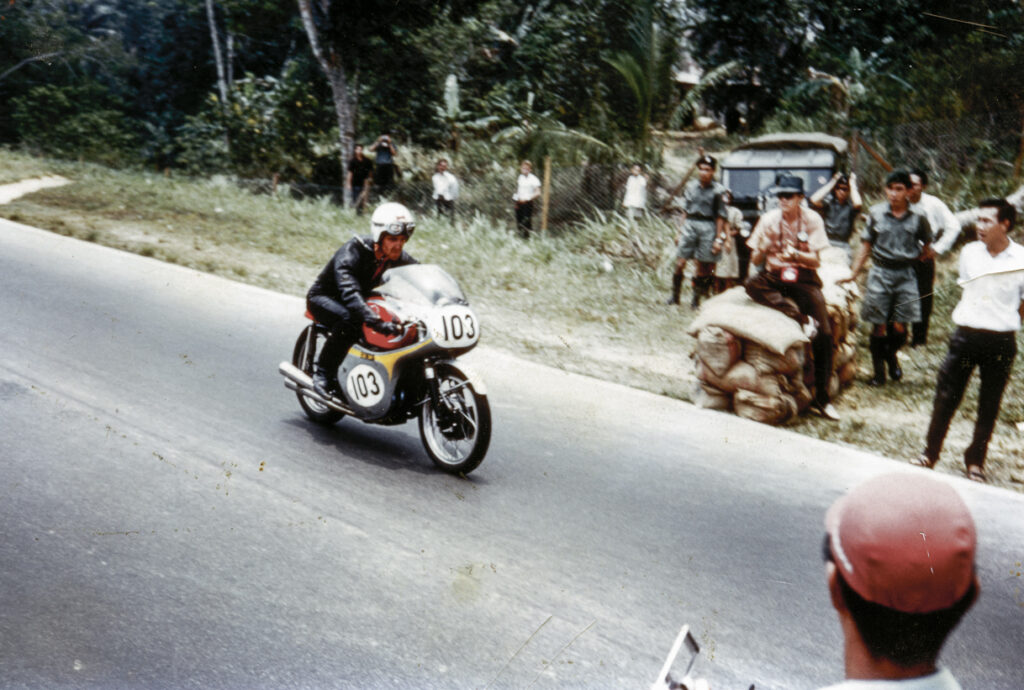
Chris Proffitt-White leads on the last lap of the inaugural Singapore Motorcycle Grand Prix in 1961.
16th and 17th September 1961 were selected as dates for the Singapore Grand Prix, on a street track at Upper Thomson that was part of a major trunk road connecting the city with Mandai, Woodlands and Johore. The Singapore Motor Club, under its President Freddie Pope, an engineer with a penchant for speed events, had long looked forward to such an event. The timing seemed right. After all, this was Visit the Orient Year (see https://rewind-media.com/2021/09/18/1961-orient-year-grand-prix/). By comparison, the Johore street track was 2.0625 miles long while the Upper Thomson Road track was 3.023 miles long. The Johore Grand Prix’s main event was over 70 laps or about 144 miles long; the Singapore Grand Prix ran for 60 laps, which worked out to over 180 miles (290 km). A fairly large fuel tank was necessary for a non-stop strategy.
Sunday was Grand Prix race day. The first race was the motorcycle Grand Prix, which began promptly at 9am. There were 32 entries. This race was really the main draw card for the weekend. In an economy where two-wheeled transport was very much the norm, it was what everyone wanted to see. Chris Proffitt-White, riding his sponsored Honda 250, took the flag ahead of Soh Guan Bee, although it was Giichi Suzuki in the newer Honda Four that led up to the very last lap. Suzuki’s Honda was equipped with a long-range fuel tank, while Prof’s bike required a pit stop to refuel. Prof managed to slip past the Japanese at Circus Hairpin as they began their last lap. In an attempt to retrieve his position, Suzuki slid off and hit the sandbags at the first chicane. There were several rumours about why Suzuki crashed out, but all are pure speculation. Prof was catching the Japanese rider towards the end – the radio broadcast is fairly clear about that. His extended fuel stop, on the other hand, was thought to have been longer than expected, and gave rise to suggestions that the team held him back and were banking on a Suzuki victory. Be that as it may, Soh Guan Bee secured second in his big Norton with Fong Kin Min and Soh Hai Yew third and fourth respectively in Nortons, and Wilkinson fifth in a Triumph. There were just seven finishers, the rest of the field had disintegrated over the course of the 60 laps. Prof had earlier finished second to Suzuki in the 15-lap 125-250cc race.
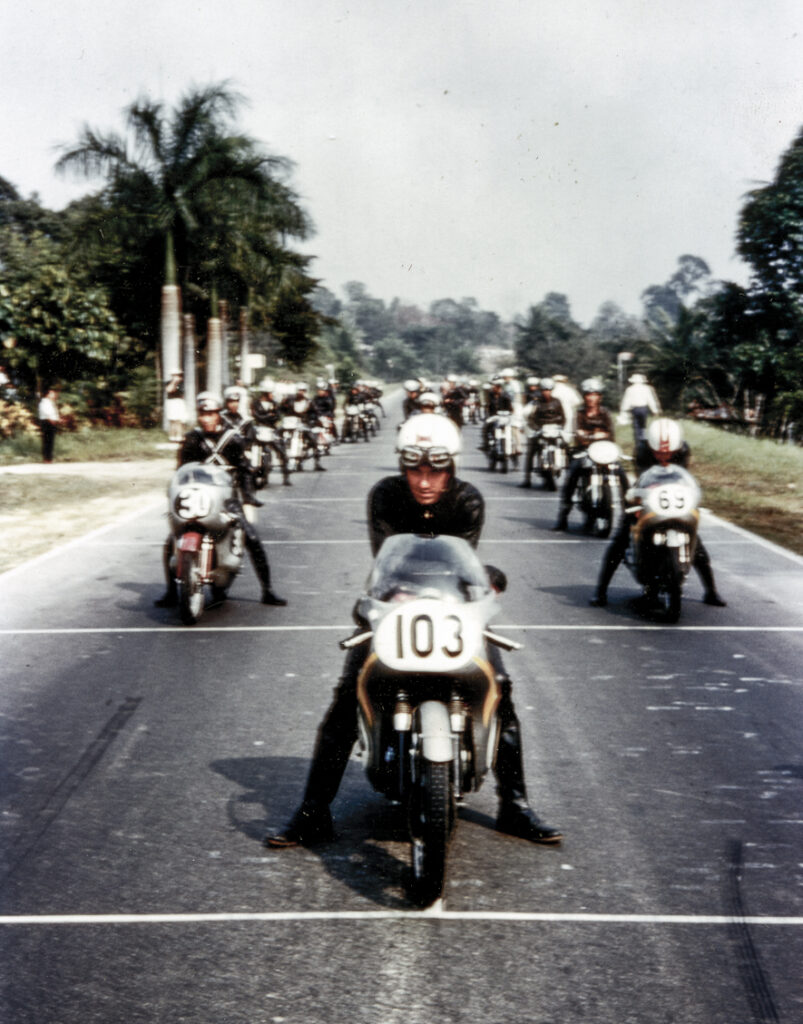
Chris Proffitt-White, Grand Prix winner, at the Start of the inaugural Singapore Grand Prix in 1961.
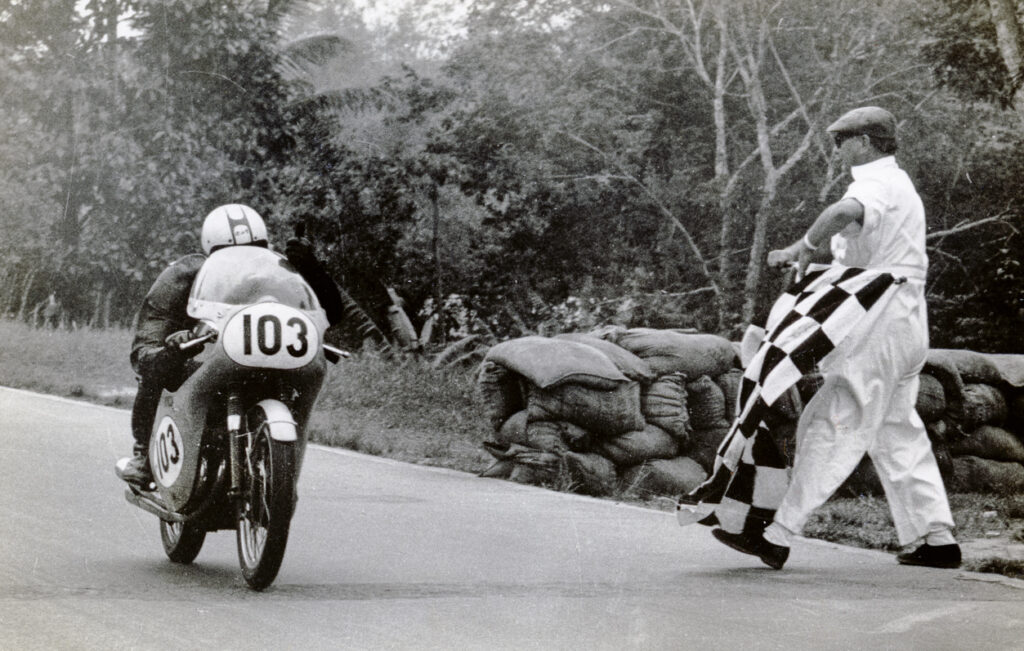
Chris Proffitt-White, Grand Prix winner, at the Finish of the inaugural Singapore Grand Prix in 1961.
BREAKING RECORDS
Less than a month later, on 8 October 1961, the New Tunku Abdul Rahman Speed Trial and Hill Climb was held at Kenny Hill in Kuala Lumpur, and attracted regional enthusiasts. Prof had never ventured outside of Singapore apart from the Johore Grand Prix, so his track time here was somewhat limited.
On 22 October 1961, the Gap Hill Climb was held and, once again, Prof shone. In the motorcycles Unlimited race, he established a new course and class record of 48.82 seconds. In fact, competing in five different classes, Prof won all the events he entered, set two class records, and established a new course record. The competition couldn’t have been more relieved – this was meant to have been his last event before his departure home. Not quite.
Shortly after, in November 1961, Prof and K.C. Wong went head to head once more, this time at that Seletar Half-Mile Standing-Start Sprint and Flying Quarter-mile sprint. Wong and his Norton Manx triumphed when he set FTD in the Standing Start Half-Mile and the Flying Quarter-Mile event in the Unlimited class runs, while Prof took two class wins in the Standing Half-Mile as well as the Flying Quarter-Mile.
Later in the month, on 26 November, Prof made another attempt on Old Upper Thomson Road for the Singapore Motor Club Sprint. Having missed the two previous sprints here (November 1960 and February 1961), he once more had to pull out of the event due to machine trouble. Old Upper Thomson Road may have been a great hunting ground for him for the Grand Prix, but for the Sprints, it was the only course record he did not yet hold.
Early in February 1962, Prof had one final go at the Gap Hill Climb, his entry limited to just three classes – the 50cc and under, 51-125cc, and the 126-250cc classes. He beat Soh Guan Bee in the 126-250cc event and Peter Eastlake in the Unlimited class. It was a fitting finale for Prof – he set a new class record of 49.35 seconds in the 126-250cc race and bettered the course record to 49.06 seconds in the Unlimited class race. Motorcycle course records he held at the time of his departure: Sembawang RASC Nursery Circuit, Gap Hill Climb, and Singapore Grand Prix lap records. Chris Proffitt-White left Singapore for the UK on 18 February 1962.
Interestingly, Prof visited Singapore once more before the 1965 Singapore Grand Prix (nee Malaysia) where he visited Honda agent Boon Siew’s new premises on the island (probably the refurbished Bukit Timah Road showroom at 75-77 Bukit Timah Road across from the K.K. Maternity Hospital).
Subsequently, Chris moved his family to Atlanta, Georgia, USA, in the early 1970s where he opened a motor garage specialising in classic machinery. The family returned to the UK a few years later and in 1989, Prof passed away, aged just 51. Shortly before his passing, Prof and Jan Bussell met up again (for more on Jan, use the keyword search at www.rewind-media.com), quite by chance, at a car wreckers yard in Banbury, Oxfordshire. It was an amusing coincidence, Jan’s wife Lynn recalled. The Bussells had recently returned to their home in Chipping Norton, Oxfordshire, and Prof and his family lived in nearby Banbury. Both racers had enjoyed catching up, their mutual respect still much evident.
APPENDIX 1
>> Introducing the Airfield Circuits
Circuit racing at the air bases was a post-war phenomenon. The Swettenham Aerodrome at Port Klang, Selangor, came close to holding the first-ever Malayan Grand Prix in 1939, foiled at the last minute by the outbreak of war in Europe. The distinction of holding the first-ever South East Asian massed-start motor sport event lies with the Kallang Airport in Singapore, in 1949, an event that local historians have largely ignored.
The Second World War made the construction of landing strips, to boost air support, a necessity. As with Silverstone and Sebring, Singapore’s motoring events on airfields also took off after the war, first with the Air Day mass-start Sprint at Kallang Airport, hosted by the Singapore Motor Club, along the perimeter track and up the runway. There were two one-mile sprint races held, with victory going to Kok Kum Woh in his K&K Special and Jimmy Milne in his J.D. Special. Following the Selangor and Pahang AAM Lornie Mile Speed Trial held in Kuala Lumpur in early July, this was the perfect opportunity to test the race cars ahead of the first post-war Johore Grand Prix that was to take place in October.
There were four RAF airbases in Singapore. RAF Changi was the Far East Air Force headquarters that included the RAF’s hospital on the island; RAF Tengah was the jet fighter and bomber station; RAF Seletar was the largest unit on the island as the maintenance outfit for the RAF, with six flying squadrons based there along with one Surface-to-Air missile squadron of Bloodhounds; and RAF Sembawang was the fleet amphibious forces’ base.
An attempt to hold a massed-start circuit race at the Sembawang R.A.S.C. Nursery Circuit in 1956 had failed. It is surprising that the 1949 Kallang Air Day race was the only massed-start race until June 1957, when the Forces Motoring Club and the Singapore Motor Club managed to orchestrate the Changi Circuit Race on RAF Changi’s airfield (which had been built during the war), eight years down the road! [see https://rewind-media.com/2021/08/13/landing-at-changi-in-1957/]
By the late 1950s and early 1960s, the RAF bases at Sembawang, Seletar and Tengah offered themselves for circuit and sprint events during the midst of the Malayan Emergency (1948-1960) and the Indonesia-Malaysia Confrontation (1963-1966). These “circuits” provided more than just a suitable location; the ‘forces’ had their own dynamic clubs (the Forces Motoring Club, Forces Driving Club and RAF Seletar Auto Club, for example – see https://rewind-media.com/2022/03/12/clubbing-in-south-east-asia/) as well as infrastructure support, beer and a very enthusiastic entry list. In Peninsular Malaysia, the RAAF Butterworth Motor Club, formed in January 1962, was just as active with racing at the Butterworth base, as well as providing personnel support for the various sprints and hill climbs at Sungei Nibong, Mount Pleasure and the Vale of Tempe.
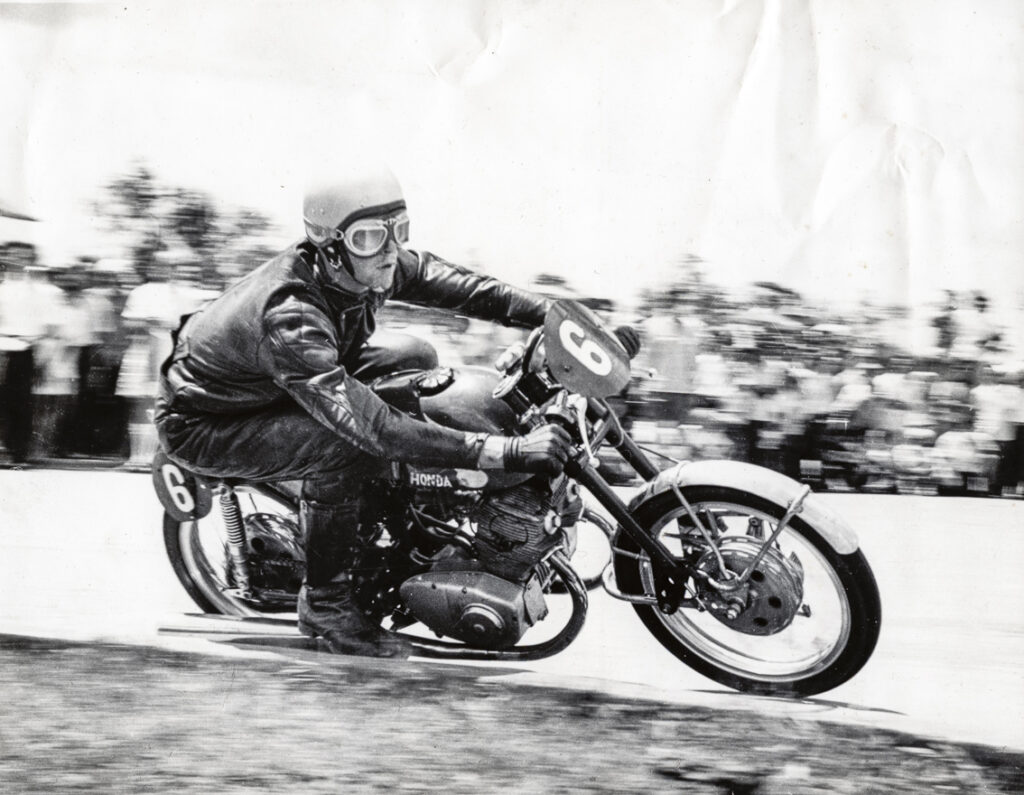
Sembawang Nursery Circuit’s Aintree Bend was tough on both cars and motorcycles.
This window of circuit racing existed over a period of only around ten years. By 1967, it was clear that the critical mass of support afforded by the British presence in Singapore and Malaysia would not last much longer, a halving of troop deployment beginning in 1969. Use of RAF airfields in Singapore had already waned by 1964. The Pound was devalued in November 1967 and in January 1968, and it was announced that all British forces would leave this region by April 1971. RAF Seletar was handed to the local government in April 1969. Final handover of RAF Changi took place in December 1971. The Sembawang airbase had been handed over earlier. RAF Tengah, on the other hand, was selected to be the main strike base for a multi-national air force following Britain’s pull out of Singapore, until Singapore’s Air Defence Command took over the base in September 1971. That rich vein of suitable roads for sprint racing was no longer and the locals did not share the same interests.
APPENDIX 2
>>RAF CHANGI – THE CATALYST
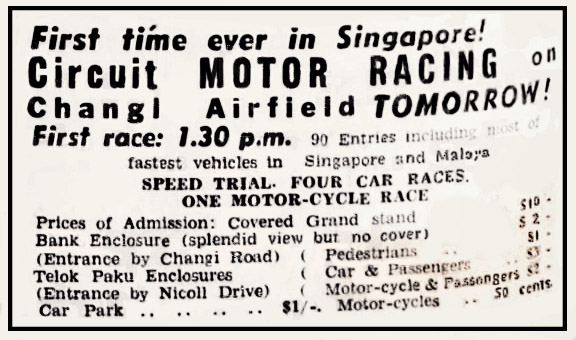
The first, and only, occasion a circuit race was held at RAF Station Changi – June 1957.
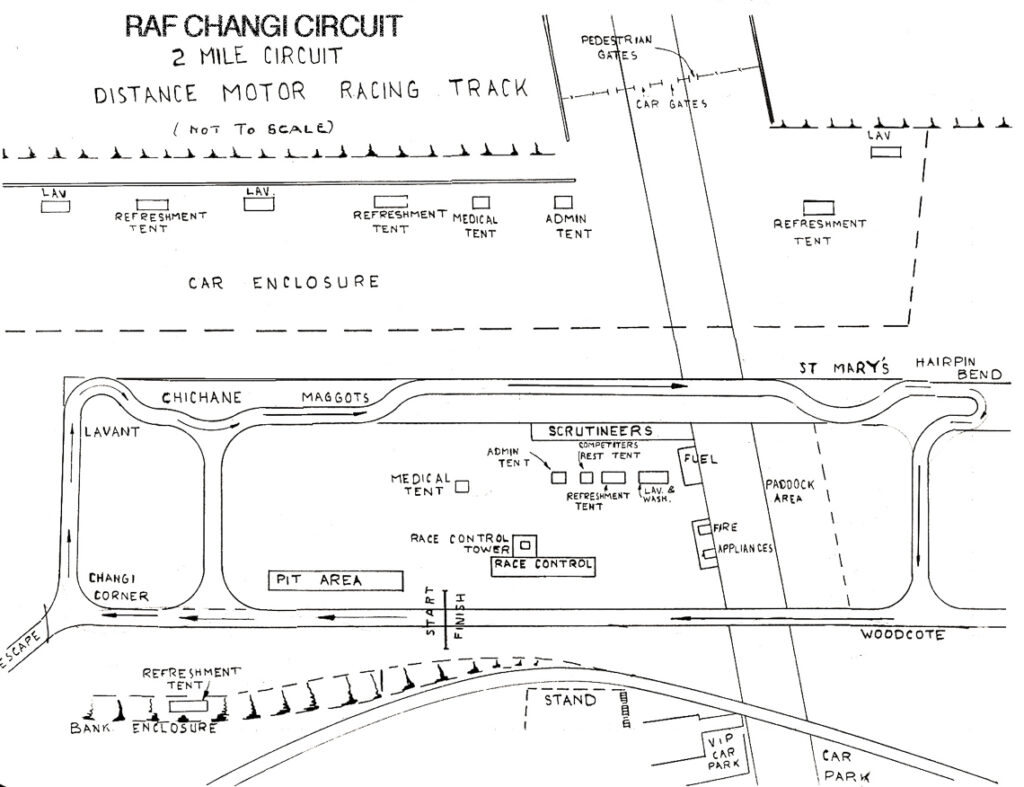
Layout of the RAF Changi Circuit.
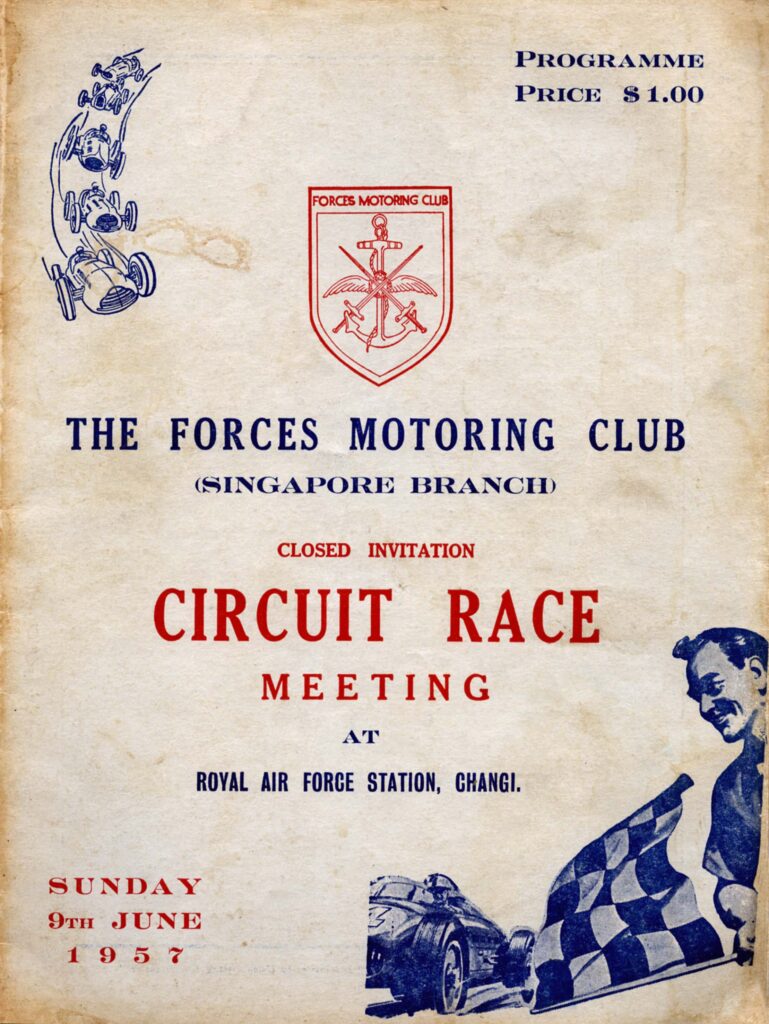
Program cover for the Changi Circuit Races.
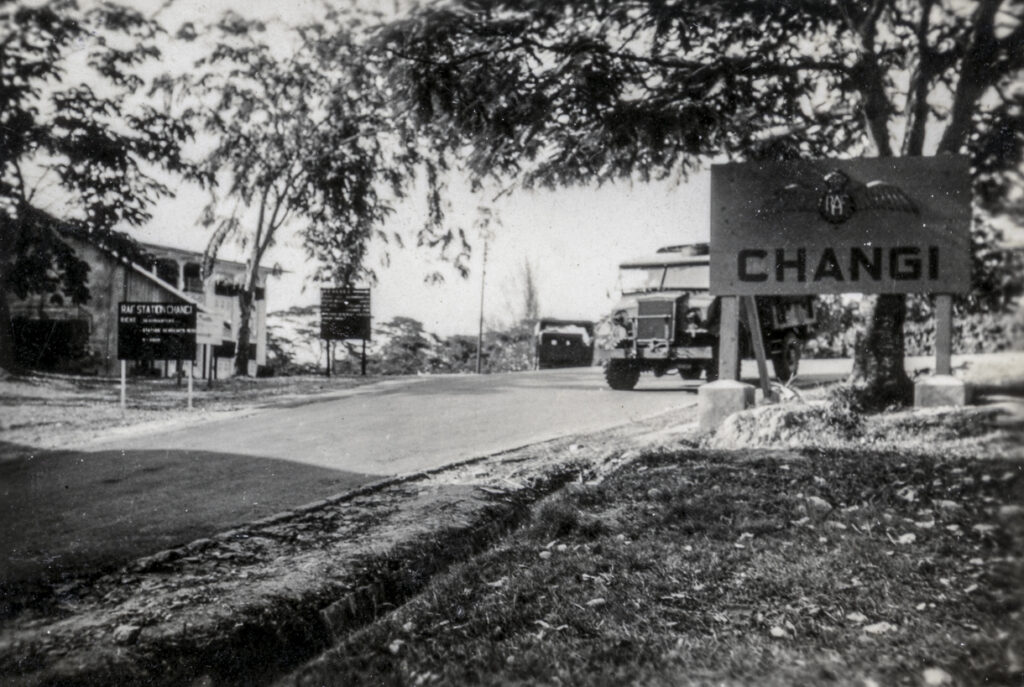
The road into RAF Station Changi in the 1950s.
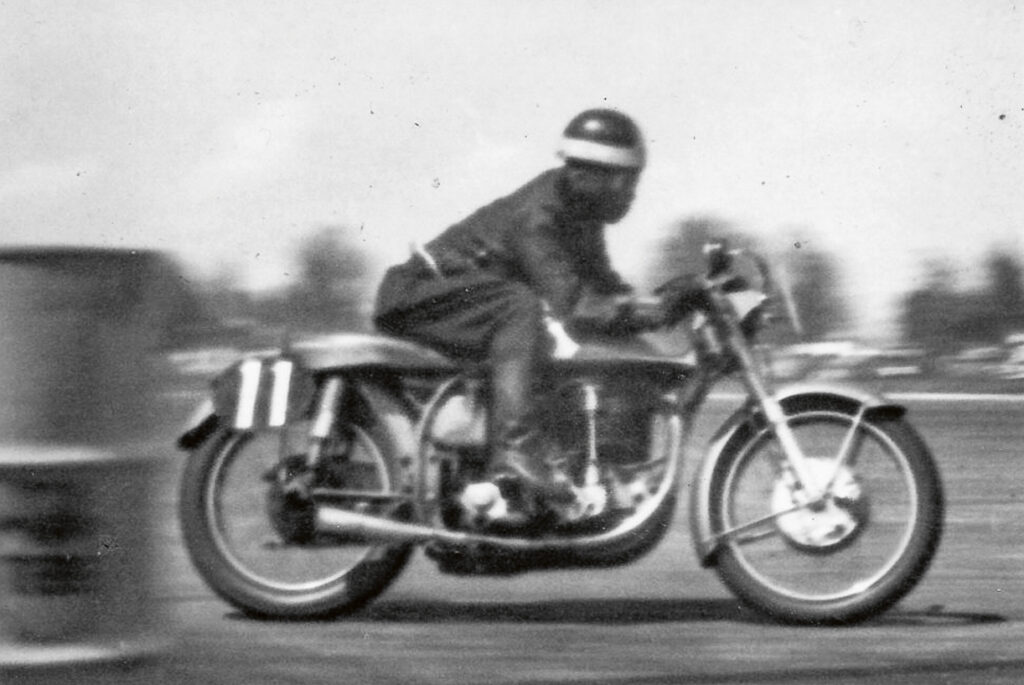
RAF Changi’s only circuit race was held in June 1957. Hamid bin Rahim entered his Norton in the 10-lap motorcycle race.
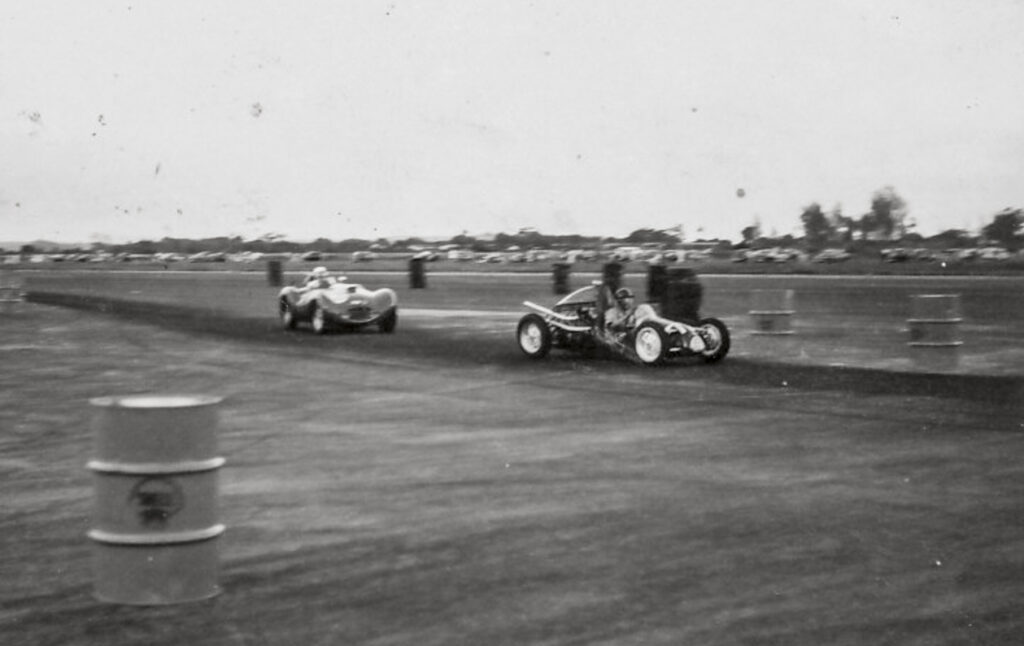
In the 10-lap Formula Libre race in Changi in 1957, Lim Peng Han and his Lim Special kept ahead of Bernard Arnold
in the Warrior Bristol.
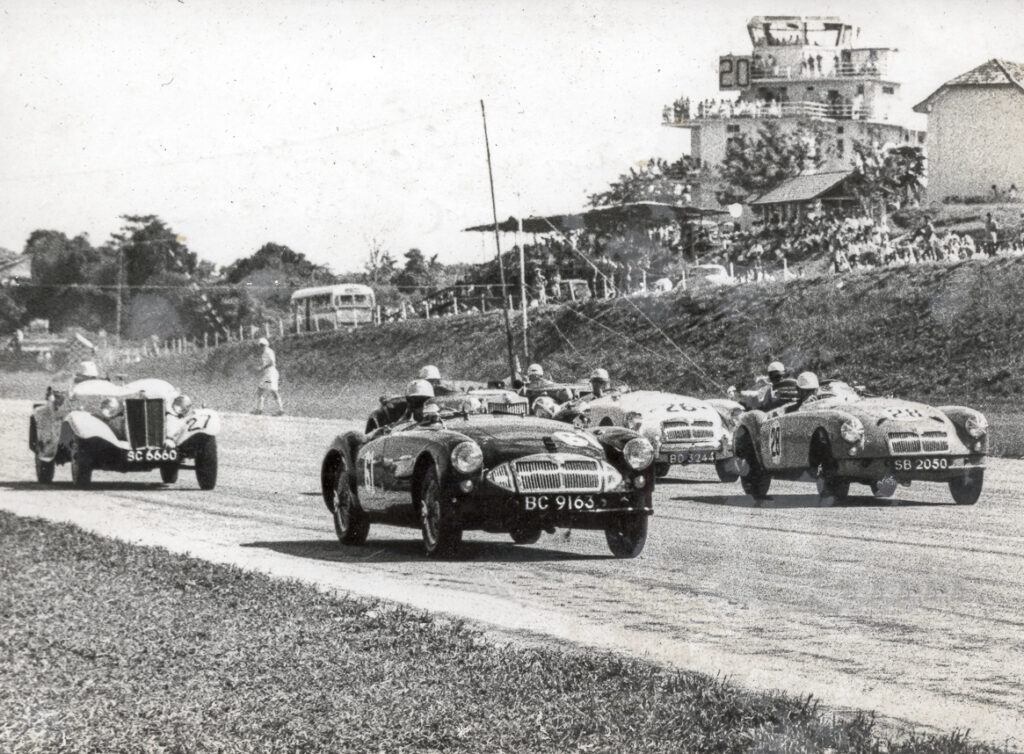
The Sports Car race at RAF Changi in 1957 was dominated by MGs and was won by Stanley Leong in his “Le Mans” MGA (No.28). C.O. “Mick” Jennings led in his Twin Cam MGA (No.61).
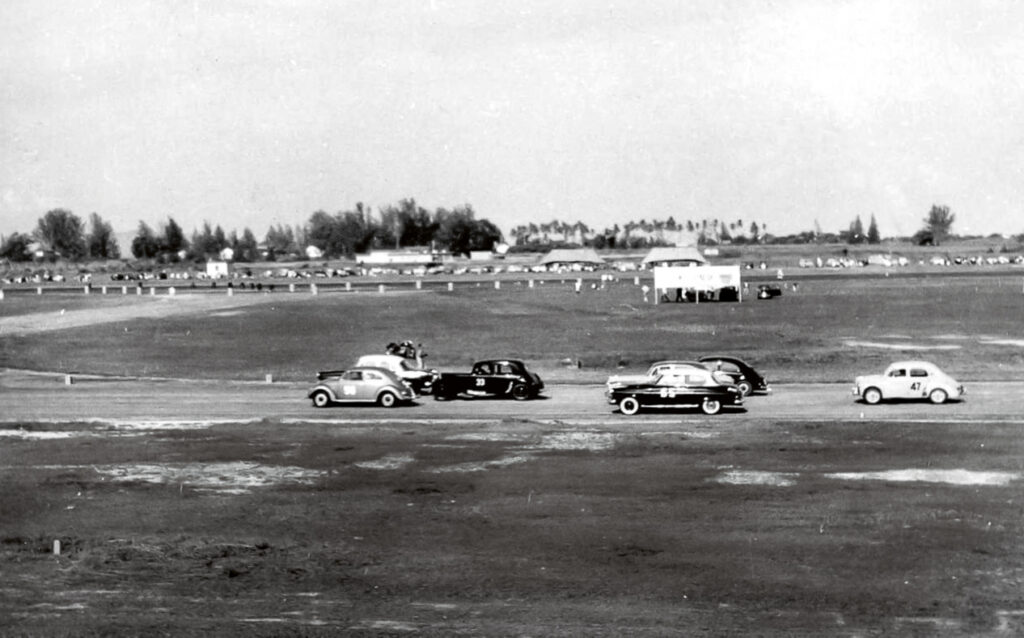
The Changi Circuit five-lap Saloon & Tourers race had a variety of cars – from Lim Peng Han’s 1.2-litre VW Beetle to Joy Landymore’s Borgward TS, Rex Carkeek’s Citroën Light Fifteen and Chan Lye Choon’s DKW.
For a small island, Singapore had an abundance of military airfields, none of which were disused after the Japanese occupation. Eventually, someone within the Forces Motoring Club of Singapore came up with the brilliant idea of seeking the support of Air Commodore Geoffrey Nicholas Ernest Tindal-Carill-Worsley, CB, CBE, President of the Club, for a race event on the Changi airfield. Fence the perimeter; pipe in some water; construct some grandstands, preferably by the control tower; round up some marshals and call it a race circuit for a weekend. They pulled it off in June 1957 with a 2.86km-long circuit, the first proper circuit race in Singapore. Motoring enthusiast and Singapore Motor Club pioneer Paul Gibbs-Pancheri wrote, “Whilst still in the village [as a PoW in Changi], I was fortunately involved in hauling trailers of rice sacks into the POW area…I dreamed of creating a racing circuit using some of these excellent roads, but never guessed that after the Japanese had built an airfield (with our labour) in this area, I would in 1957 drive my Bentley in races on the roads that had been built as Changi Airfield.” The main race was won by Chan Lye Choon in his Aston Martin DB3S. The event, however, was a one-off. [Full story in Rewind Magazine 006 as well as at https://rewind-media.com/2021/08/13/landing-at-changi-in-1957/]
APPENDIX 3
>> Sembawang Nursery Circuit – Massed-start racing
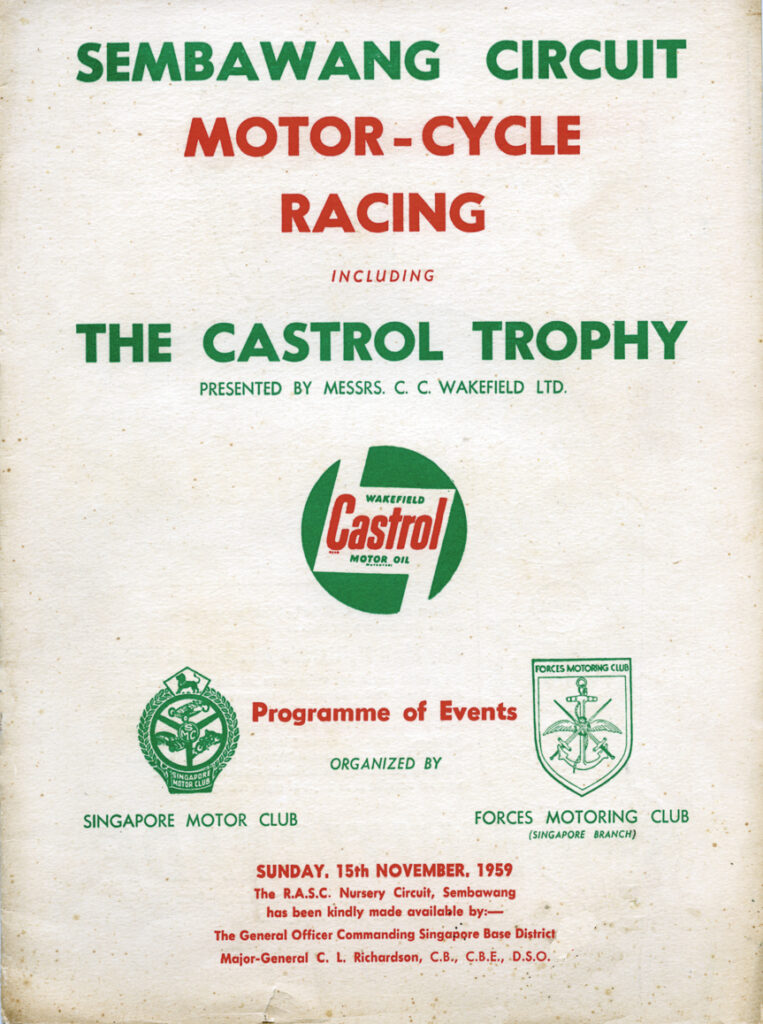
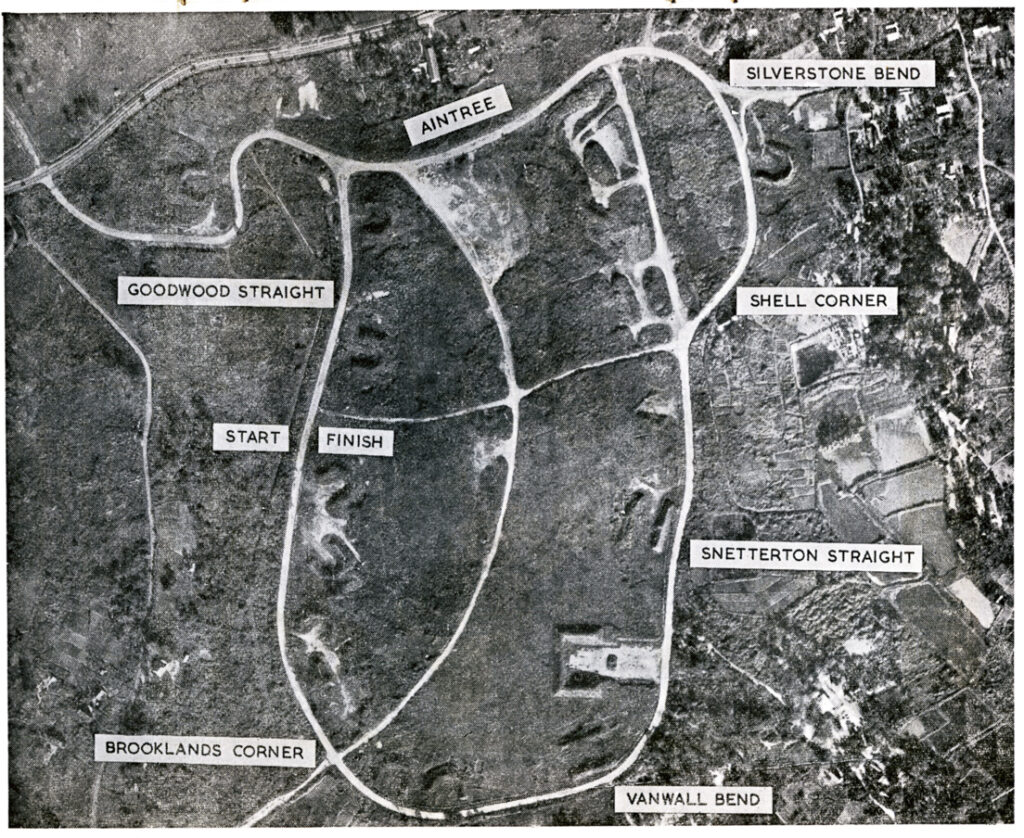
The RASC Sembawang Nursery Circuit in 1963.
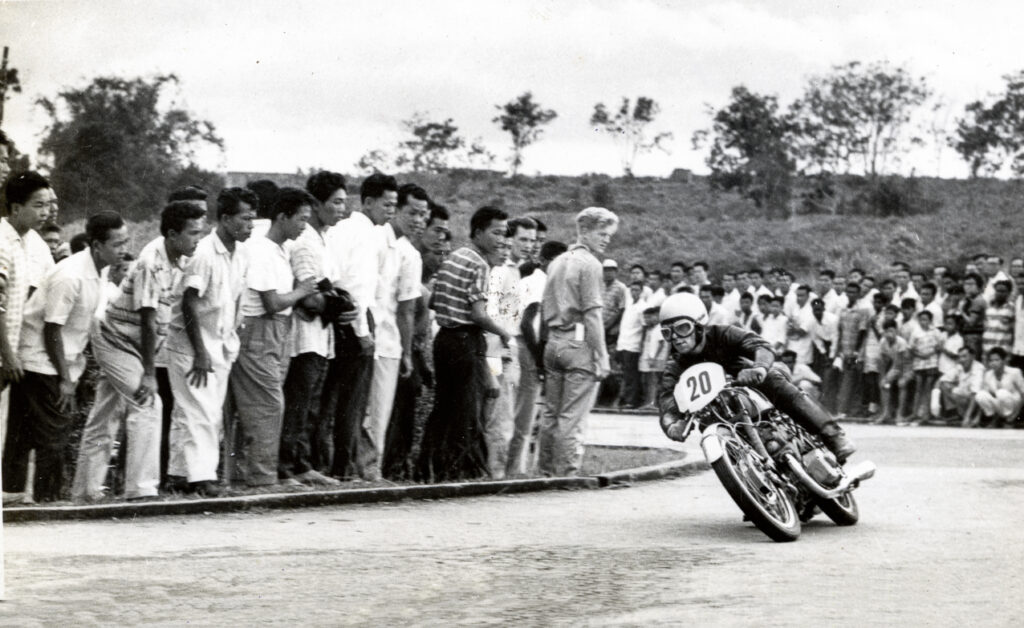
Chris Proffitt-White made his debut at the Castrol Trophy races at Sembawang Nursery Circuit in November 1960 with the ex-K.C. Wong Honda Twin. He called the 1.2-mile circuit a “cross between a racetrack and a scramble course.” Obstacles included dogs and cows.
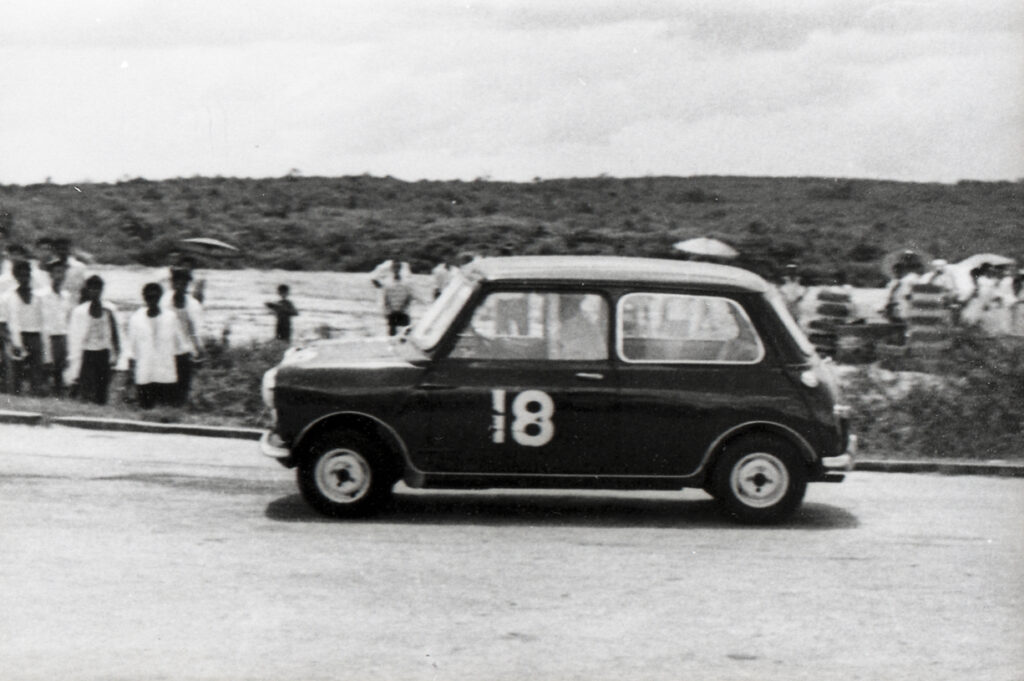
A well known Mini at Sembawang.
First mooted as a site for circuit racing in May 1956 by the Singapore Motor Club, a race was planned for 5 August that year around a 1.15-mile course that was so narrow, overtaking was unlikely. The event never did take place as approvals were not forthcoming from the base. It wasn’t until 1959 that a massed-start race was first held at the Royal Army Service Corps driver-training Nursery Circuit on Sunday, 14 June. The 1.2-mile circuit was also the ideal replacement for the Forces Motoring Club’s Dover Road Sprint, originally scheduled for 6 September 1959 which did not materialise because approval for use was not forthcoming. The corners and straights were named after famous names in British motor sports such Goodwood, Aintree etc. The last motor sport event at Sembawang, the Forces Motoring Club Summer Sprint, was held on 14 July 1963.
APPENDIX 4
>> RAF Seletar – All about sprints
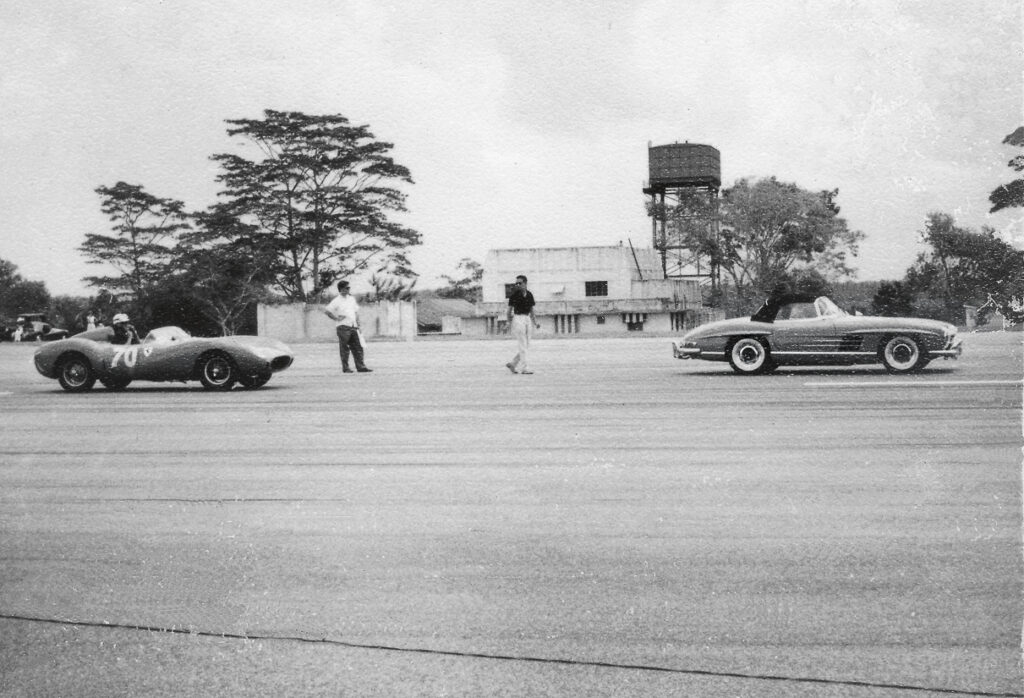
A Johore-entered Mercedes 300SL lines up in front of the Singapore-built S.L. Ferrari during of one of the Seletar Sprints in the early 1960s.
RAF Seletar was a Royal Air Force station between 1928 and 1971 and closed at the end of March 1971. The airbase was handed over to the Singapore Air Defence Command, which became the Republic of Singapore Air Force after the British pull-out.
Mention “Seletar” and the first thing that we think of is the old R.A.F. airbase. Dig deeper amongst the locals and the road with food stalls that leads to the guard post spring to mind. Jalan Kayu that links Yio Chu Kang Road to Seletar Airbase was named after the first Principal Works and Buildings Officer for Seletar, C.E.O. Wood. Wood arrived in April 1927 to oversee the arrival of the Far East Flight of four flying boats. In recognition for the work Wood put into developing the entire base, the road leading into the base was named after him, but translated into the Malay language! [see https://eresources.nlb.gov.sg/newspapers/Digitised/Article/straitsbudget19340531-1.2.25?ST=1&AT=search&k=c.e.%20woods%20seletar&QT=ce,woods,seletar&oref=article]
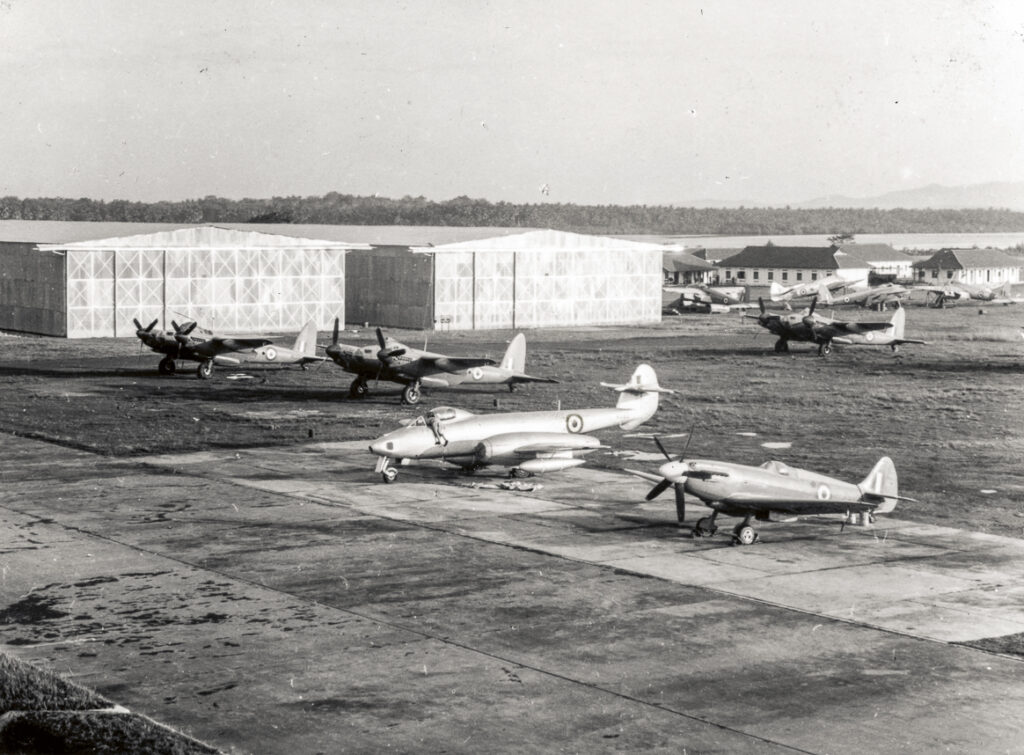
Spitfires, Meteors and Mosquitos at RAF Seletar.
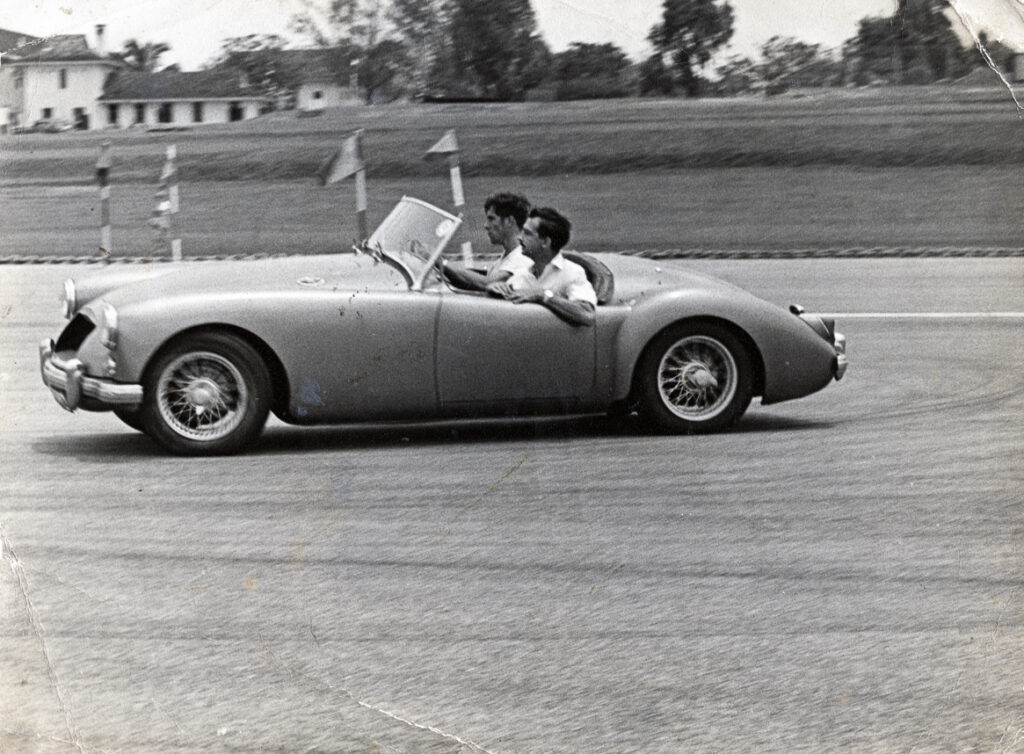
Chris Proffitt-White entered his MGA in one of the regular Seletar Auto Club tests at the base. A nervous journalist hangs on as passenger.
In early 1959, there was a short impasse at RAF Seletar with no fully operational squadrons based there till April, when Air Headquarters Malaya was moved from Kuala Lumpur to reform at Seletar as Headquarters 224 Group. As a fully operational short- and medium-range transport base, RAF Seletar rapidly grew. A little township, ‘Seletarville’, was created, with a community centre, a Church of England, and all sorts of clubs – from angling to photography. And, of course, an auto club for motoring enthusiasts. The first Seletar quarter-mile sprint took place in March 1960. The RAF Seletar Auto Club was formed in September that same year.
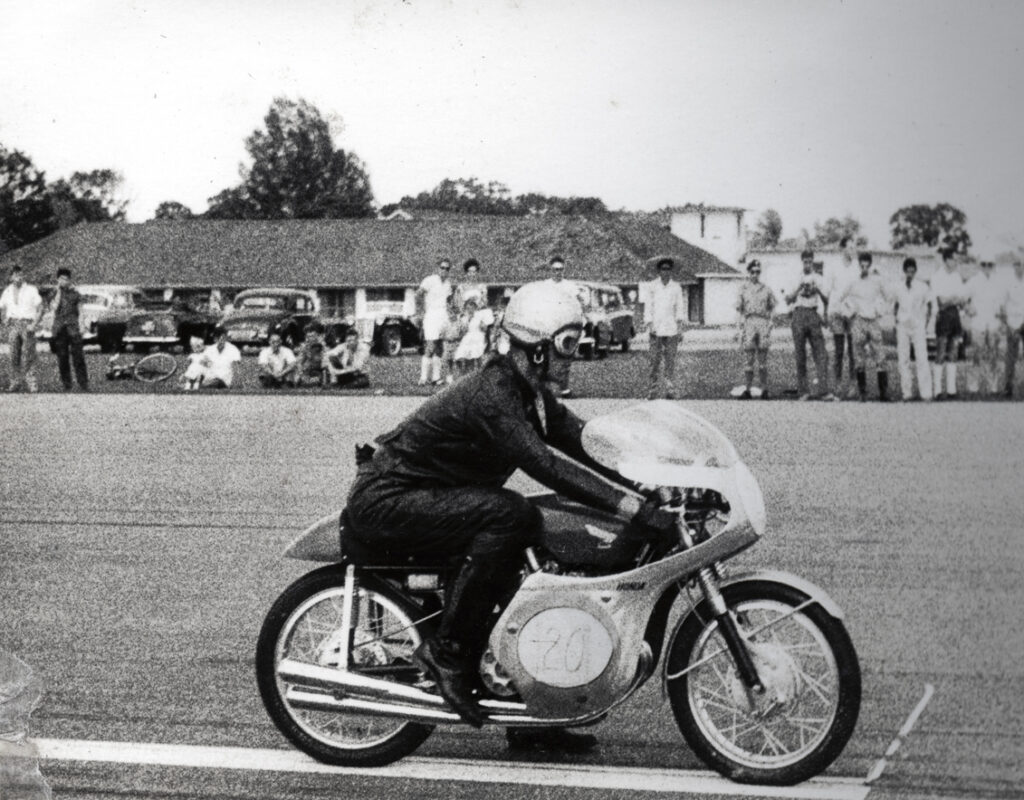
Chris Proffitt-White on his Honda Four at Selatar.
The airbase continued to host the annual quarter-mile sprint until 1964, although after this, the RAF Seletar Auto Club was very active in all aspects of motoring which also included driving tests (in what appears to have been a regular event held at the East Camp from October 1960), night rallies, treasure hunts and gymkhanas. The club was also involved in the South Malaysian Motor Rally in February 1964, a 400-mile event jointly sponsored by the Singapore Motor Club, Forces Driving Club, Seletar Auto Club and Incorporated Society of Planters’ Car Club.
APPENDIX 5
>> RAF Tengah – A One-Off
Work began on RAF Station, Tengah, Singapore’s second Service aerodrome, in November 1933. The aerodrome was officially opened in early November 1936. Situated off Choa Chu Kang and Lim Chu Kang roads, the 192-acre base on the west of the island was built for land planes only.
During the Malayan Emergency (1948-1960), Tengah was used to house Avro Lincolns of the Royal Air Force and the Royal Australian Air Force, which performed bombing missions on communist guerrilla sites in Malaya. In 1954, the R.A.F. was re-equipped with Venom FB4s and Vampire T11s of the 60 Squadron and was joined by the 14 Squadron of the Royal New Zealand Air Force (R.N.Z.A.F.). In 1958, these were further joined by the 45 Squadron R.A.F. and 75 Squadron R.N.Z.A.F. with Canberra B2s. The Royal Australian Air Force retained their Lincolns with No 1(B) Bomber squadron until the end of the emergency.
During the period of the Indonesia-Malaysia confrontation, to bolster the air defence of Singapore and Peninsula Malaysia against air incursions from P-51 Mustangs and MiG-21s of the Indonesian Air Force, the R.A.F. deployed the 74 Squadron with English Electric Lightning F6s followed by the 20 Squadron with Hawker Hunter fighters in addition to the Gloster Javelins of the 60 Squadron and 64 Squadron.
The station closed at the end of March 1971. RAF Tengah was then handed over to the Singapore Air Defence Command (later the Republic of Singapore Air Force) after the British pull out.
RAF Tengah hosted its first one-kilometre straight-sprint for cars and motorcycles along its runway on 18 March 1962. The event was organised by the RAF Seletar Auto Club and was open to members of all sporting car clubs in Singapore and Malaysia. FTD was set by Lim Peng Han in his Lim Special with a time of 26.01 seconds, with Stanley Leong second in his Lotus 15-Ferrari, nicknamed the Ferratus. Motorcycle FTD went to F.K. Wong at 26.70 seconds in a Norton. It appears to have been the only occasion a sprint race was held on the base.
APPENDIX 6
>> HMS Simbang – The Odd One
Asprint race at HMS Simbang, Sembawang? Located four miles from Sembawang Naval Base, the Royal Naval Air Station in Sembawang, the first Naval Air Station in Malaya, was commissioned in December 1945. Simbang is the Malay name of a powerful frigate bird. On 15 May 1965, a “last minute” Summer Sprint was organised here. The third Simbang Sprint was held on 1 August 1965, the event now popular with the race car crowd. A week later, the Boon Lay Festival Sprint took place, racing enthusiasts now spoilt with back-to-back events here. Records reveal that after seven years in operation from 1945, the base was closed in April 1957 and taken over by the British Army. In 1967, HMS Simbang was the fleet amphibious forces’ base for the Far East. By 1971, ANZUK (the tripartite force formed by Australia, New Zealand and the UK to defend the Asian Pacific region) had assumed control over Simbang. Simbang was then renamed Sembawang Air Base when it was handed over to the Singapore Air Defence Command.
Examples of the various circuits and roads used by the Singapore Motor Club, Forces Motoring Club & Forces Driving Club
Singapore Trophy Speed Trial [Farrer Road] – Sept.1938
Pasir Panjang Gap Hill Climb – Sept. 1927 – Sept.1973
Bukit Batok Hill Climb – Apr.1948 – Jun.1956
Pender Road Hill Climb – Oct.1948
Lim Chu Kang Half-Mile Sprint/Flying Quarter Mile – Jan.1949 – Mar.1959
Kallang Airfield – Singular massed-start event – Aug.1949
Dunearn Road Kilo – Feb.1952 – Jun.1954
Princess Elizabeth Estate Sprint – Mar.1956 – Jul.1959
RAF Changi Circuit Race – Jun.1957
Forces Motoring Club Dover Kilo – Sept.1957 – Jan.1960
Sembawang RASC Nursery Circuit – Jun.1959 – Summer Sprint Jul.1963
Seletar Airfield Sprint – Mar.1960 – Mar.1963
Old Upper Thomson Road Sprint – Jul.1960 – Mar.1973
RAF Tengah Kilo Sprint – Mar.1962
HMS Simbang Sprint – May1965 – Jun.1966
Boon Lay Road Festival Sprint Standing Quarter-Mile – Aug.1965 – Jul.1967
Mobil Sprint [Jurong] – May1967 – Aug.1968
I would be delighted to hear from you if you know of other venues beyond what is stated above as this is an amateur’s attempt at documenting Singapore’s motor sports history. I have, however, limited my research here to the period till late 1973 when motor racing (auto cross and car park auto tests are not on my radar) ceased to be permitted in Singapore.

